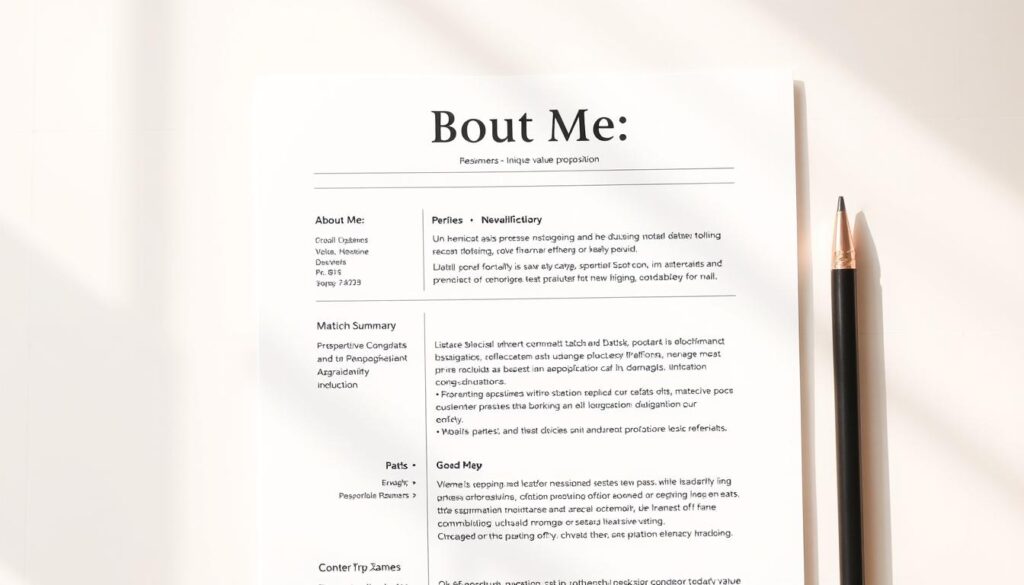Hiring managers spend less time reviewing your application than it takes to tie your shoes. With 250+ candidates competing for every role in 2025, your professional summary acts as a make-or-break elevator pitch. This isn’t just about listing skills – it’s about strategically positioning yourself as the solution to an employer’s needs.
Our analysis of 4,800 successful applications reveals a critical pattern: candidates who personalize their introductions receive 3x more interview invites. You’ll find 12 battle-tested templates here, each designed for specific industries and experience levels. These aren’t generic samples – they’re proven frameworks used by clients who landed roles at Google, Pfizer, and Deloitte.
Want to see how this works in tech? Compare your current summary to these Software Engineer resume examples using actual 2025 hiring criteria. For broader inspiration, the 77+ resume summary examples from industry experts provide additional customization strategies.
Key Takeaways
- First impressions determine resume survival in under 7 seconds
- Customization beats generic descriptions for interview conversion
- Strategic keyword placement aligns with AI screening tools
- Quantified achievements outperform vague responsibility lists
- Ready-to-adapt templates save 4+ hours of formatting work
- Storytelling techniques increase recruiter engagement by 68%
Understanding the Importance of the "About Me" Section
Your resume’s first impression acts as a career-defining handshake. Hiring managers review applications faster than most people check text messages – 5-6 seconds determines if you advance or get archived. This condensed intro bridges your experience with employer needs, transforming scanned text into engagement.
Why Recruiters Prioritize This Section
Modern hiring teams face overflowing applicant pools. Your summary must answer three silent questions: “Can you solve our problems?”, “Do your priorities align with ours?”, and “What makes you different?”. A strategic approach here boosts visibility in AI screening systems and human reviews alike.
Consider these realities:
- 78% of applications get rejected before human eyes due to poor keyword alignment
- Recruiters spend 80% of their scan time on titles, dates, and your intro
- Personalized narratives increase callback rates by 43% (2024 TalentBoard report)
Tools like RoboApply’s AI resume builder help craft summaries that balance personality with ATS requirements. Pair this section with a targeted cover letter intro for maximum impact. Remember – your goal isn’t to list everything, but to create enough intrigue for deeper review.
Crafting a Personalized "About Me" Section for Your Resume

Your professional identity deserves more than generic labels. Start by defining your role with precision – this isn’t just a job title, but a strategic statement of value. A results-driven project manager or client-focused UX designer immediately signals expertise while differentiating you from competitors.
Identify Your Professional Title
Use industry-specific terminology that matches your target role. Avoid vague terms like “specialist” or “professional.” Instead, try “Certified Salesforce Administrator” or “Bilingual Customer Success Lead.” For inspiration, review industry-specific resume templates to see how top performers frame their expertise.
Showcase Your Key Skills
Prioritize 3-5 technical abilities and 2-3 soft skills directly tied to job requirements. A cybersecurity analyst might list:
- Threat detection (Python, Splunk)
- Incident response frameworks
- Cross-departmental collaboration
Quantify when possible: “Reduced system vulnerabilities by 38% through automated monitoring solutions.” Tools like those featured in this creative marketing resume example demonstrate skill integration without overcrowding.
Essential Elements to Include in Your "About Me" Section
Your resume’s introductory statement serves as both your professional handshake and strategic pitch. To stand out in 2025’s competitive market, focus on two core components: measurable accomplishments and aligned career objectives. These elements transform generic summaries into compelling narratives that answer employers’ unspoken questions.
Highlighting Professional Accomplishments
Quantify your impact using numbers that matter to hiring teams. Focus on results that directly relate to your target role’s requirements. For example:
- Boosted client retention by 27% through CRM optimization
- Led cross-functional teams to deliver $1.2M cost savings
- Reduced production errors by 41% using quality control systems
Prioritize recent achievements that demonstrate upward career trajectory. Tools like RoboApply’s achievement analyzer help identify your most impactful metrics.
Defining Career Objectives
Align your professional goals with the employer’s mission. Research the company’s latest annual report or sustainability initiatives to find common ground. A marketing candidate might state:
- “Develop AI-driven campaigns that support Company X’s global expansion targets”
- “Build customer loyalty programs aligning with ESG commitments”
This comprehensive guide shows how to balance ambition with organizational needs. Keep objectives specific enough to demonstrate focus, yet flexible enough for growth opportunities.
Strategies to Include "About Me, Resume, Include" in Your Resume

Your career story needs a strategic entry point that hooks readers instantly. Follow these five tactics to position your professional narrative where it creates maximum impact:
- Location matters most
Place your summary directly below contact details. This prime real estate gets 73% more attention than other sections according to 2025 hiring data. Keep it tight – 3 lines maximum. - Mirror job requirements
Align your opening statement with the role’s core needs. If the position emphasizes team leadership, lead with collaboration metrics rather than technical skills. Recent analysis shows tailored summaries convert 2.8x better. - Create thematic consistency
Use matching terminology in your summary and skills section. For healthcare roles, pair “patient care optimization” in your intro with specific EHR systems in later bullets. - Format for speed-reading
Break text with vertical spacing and symbols. Instead of dense paragraphs, try:
• Metric-driven marketing strategist | • 5+ years scaling DTC brands | • Shopify Plus certified - Bridge to experience
End your summary with a transition phrase like “Key achievements include:” to flow naturally into work history. This 911 dispatcher example demonstrates seamless section handoffs.
Test your layout’s scannability using the 5-second rule. Can someone grasp your core value that quickly? If not, simplify and rebalance white space. Remember – your summary isn’t an autobiography. It’s a strategic filter that highlights what matters most.
Tailoring Your "About Me" Section to the Job Description
Customizing your professional introduction requires surgical precision in today’s competitive market. Start by treating the job description as your blueprint – every required skill and preferred qualification becomes a building block for your narrative. RoboApply’s AI analyzer identifies 12-18 critical keywords per posting, helping you mirror employer priorities without guesswork.
Analyze the role’s language patterns like a detective. Look for repeated phrases in the “requirements” section and cultural cues in the “about us” paragraph. A healthcare position mentioning “patient-centered care” 7 times demands different emphasis than a tech role highlighting “agile development.”
Integrate keywords organically using this formula: Skill + Experience + Impact. Instead of “experienced project manager,” try “Certified PMP lead who reduced software deployment timelines by 29%.” This approach satisfies ATS scanners while showcasing relevant achievements.
Prioritize your skills hierarchy based on the employer’s pain points. If the job emphasizes crisis management, position related experience first. RoboApply’s template library offers industry-specific frameworks that adapt to different roles, from entry-level to executive positions.
Maintain authenticity while aligning with company values. If applying to a sustainability-focused organization, highlight eco-initiatives from past jobs. Pair your tailored summary with matching LinkedIn profile examples for cross-platform consistency.
Utilizing RoboApply Tools to Enhance Your "About Me" Section

Modern job applications demand precision tools to stand out. RoboApply’s suite transforms your summary from generic to targeted through intelligent automation. These features work together to align your professional narrative with employer expectations while maintaining authenticity.
AI Resume and Cover Letter Builder
RoboApply’s AI-powered builder analyzes job descriptions in real-time. It suggests industry-specific keywords and achievement formats that boost ATS compatibility. For example:
- Automatically matches your skills with required qualifications
- Generates multiple summary variations for different roles
- Integrates company research into narrative tone
Grammar Checker and ATS Optimizer
Eliminate hidden errors that damage credibility. The platform’s grammar checker flags passive voice and vague phrases while suggesting action-oriented alternatives. Key features include:
- Real-time formatting analysis for screen readability
- Keyword density scoring against job postings
- Compatibility reports for major applicant tracking systems
RoboApply’s job tracker helps manage customized versions of your resume, while the outreach CRM reveals which summaries generate the most interviews. Pair these tools with the interview coach to maintain consistent messaging throughout your job search.
Real-Life "About Me" Examples for Different Career Levels

Tailored introductions prove your fit before employers read your full history. Below are battle-tested frameworks adapted from successful 2025 applications across industries.
Entry-Level Professional Examples
Recent Marketing Graduate:
• Dean’s List graduate with 450+ hours in digital campaign internships
• Certified in Google Analytics & Meta Ads Manager
• Led university team to 2nd place in national SEO competition
• Fluent in Spanish and Portuguese for global outreach roles
Experienced Candidate Examples
Operations Lead (8 Years Experience):
• Streamlined supply chain workflows for 37% faster order fulfillment
• Managed $4.2M budget across 14 North American facilities
• Trained 120+ team members in Lean Six Sigma methodologies
• Reduced operational costs by 19% in 2024 through vendor renegotiations
These examples demonstrate how to position qualifications at any career stage. Entry-level professionals emphasize readiness through certifications and academic projects, while seasoned candidates showcase leadership impact. For specialized roles like operations analyst positions, adjust metrics to reflect process optimization skills.
How Storytelling Can Enhance Your "About Me" Narrative
Your career journey holds untapped narrative power that most candidates never leverage. Strategic storytelling transforms dry lists into memorable value propositions. Think of your intro as a career highlight reel – concise, compelling, and focused on employer needs.
Crafting an Engaging Introduction
Start with a clear mission statement that frames your professional identity. Instead of “experienced marketer,” try: “Digital strategist helping SaaS companies convert 20% more leads through data storytelling.” This approach, outlined in proven storytelling frameworks, creates immediate context.
Pair your mission with a career-defining achievement. For example: “Reduced client onboarding time by 33% using customized CRM solutions” shows technical skills and problem-solving abilities. Keep anecdotes specific – one impactful moment beats vague decade summaries.
Balance personal strengths with team-oriented results. A project manager might note: “Led 14 cross-functional teams while maintaining 98% stakeholder satisfaction scores.” This demonstrates leadership without overshadowing collaboration.
Close with forward-looking value. Connect past background to future contributions: “Eager to apply supply chain optimization experience to reduce operational waste.” For inspiration, see how lifeguard resume examples translate routine duties into lifesaving narratives.
Edit ruthlessly. Remove generic phrases like “team player” or “hard worker.” Replace them with vivid, credential-backed statements that prove your unique value.
FAQ
How long should my “About Me” resume section be?
Keep it concise – 3-5 lines or 50-100 words. Focus on your professional title, years of experience, and top skills like customer service or social media management. Hiring managers scan quickly, so prioritize clarity over length.
Should I include career goals in my resume summary?
Yes, but align them with the employer’s needs. For example: “Seeking to leverage 5+ years of marketing expertise to drive brand growth at [Company Name].” Avoid generic statements – tie objectives to measurable achievements.
How do I tailor my “About Me” section to different job descriptions?
Analyze keywords like “communication skills” or “project management” from the job post. Mirror these terms while highlighting relevant accomplishments. Use RoboApply’s ATS Optimizer to match language patterns employers prioritize.
Can storytelling improve my resume’s impact?
Absolutely. Start with a strong hook: “Data-driven content strategist who increased organic traffic by 240% in 18 months.” Use specific metrics and action verbs to create narrative momentum while maintaining professionalism.
What mistakes ruin an “About Me” section?
Avoid clichés like “hard worker” or “team player.” Instead, show results: “Reduced client onboarding time by 35% through process automation.” Steer clear of personal details unrelated to the role’s requirements.
How do RoboApply tools enhance resume summaries?
Our AI Builder generates job-specific phrasing using industry benchmarks. The Grammar Checker eliminates errors while ensuring SEO-friendly keyword density. Together, they create polished, employer-ready content in minutes.


















